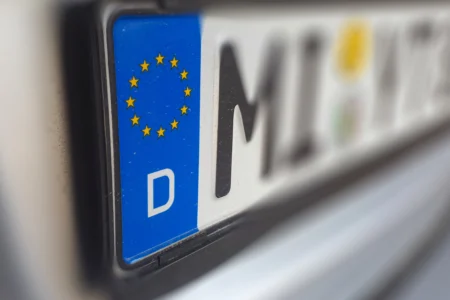The Meaning Behind UK’s White and Yellow Number Plates
Most car owners rarely think twice about this detail until they need to replace or customise a number plate. Why are number plates yellow and white in the UK? Why not red, blue, or green? What makes white front plates and yellow rear plates so important? At JDM Plates, we often get asked this question by customers exploring show plates, replacements, or personalised plates.
Whether you’re upgrading your registration plate, learning about UK plates, or just curious about different colours, this article will explain the reasoning, legal background, and practical benefits behind the UK’s iconic two-colour plate system.
Why Are Number Plates Yellow and White in the UK?
The UK’s colour scheme, with white plates at the front and yellow plates at the back, was introduced to increase road safety and enhance visibility. Number plates yellow at the rear help drivers and speed cameras spot and identify vehicles clearly from behind, while white front plates make vehicles more visible when approaching.
Using white and yellow plates ensures a strong contrast ratio with the displayed black alphanumeric characters (letters and numbers). This contrast is vital for automatic number plate recognition (ANPR) systems, human visibility, and vehicle licensing agency requirements.
When Did the UK Introduce White and Yellow Plates?
UK number plates have evolved significantly since the early 1900s. The current colour number plates system was made mandatory in 1973, when the government moved from black plates with silver characters to the now-standard white background at the front and yellow background at the rear.
The switch was made primarily for visibility and compliance with new reflective material standards, which made number plates easier to read in low-light and high-speed situations. The goal was to improve the safety of UK roads, especially at night or in poor weather conditions.
Why Do Rear Plates Have to Be Yellow?
The use of yellow number plates at the back of a car is rooted in practical safety. Yellow is a colour that contrasts sharply with black lettering, and it stands out well under headlights, fog, or dim conditions. This high contrast allows other drivers and speed cameras to identify the registration plate easily.
Moreover, yellow is more reflective than many other colours, making it ideal for use at the rear, where most visibility challenges arise. The yellow hue is particularly effective when illuminated by the white light of car headlights, ensuring that the rear number plate is visible from a distance.
Why Do Front Plates Have to Be White?
White plates at the front of the vehicle serve a similar purpose, but for incoming traffic and laser-sighted weapons or targeting systems used by enforcement. The white colour reflects more light, ensuring high contrast with black characters without being too harsh on visibility.
In contrast to the yellow rear plates, front plates show a white background. This background works with the white or silver characters of headlamp reflections, ensuring safe and compliant identification. This setup helps both manual enforcement officers and technology like ANPR.
The Legal Requirements for UK Number Plate Colours
All UK cars must adhere to strict DVLA regulations, which dictate that:
- Front plates must have a white background with black characters.
- Rear plates must have a yellow background with black characters.
- All plates must use reflective material.
- No background patterns are allowed on license plates.
- Grey characters, silver characters, or any coloured plates are only legal on vintage or military vehicles under specific rules.
Failure to meet all the rules around number plate colours can result in a fine, MOT failure, or even the withdrawal of the registration plate.
Why Not Just One Colour for Both Plates?
Some may wonder why the UK doesn’t simply adopt one colour for both the front and back, like some other countries do. The reason lies in a combination of tradition, legal compliance, and visibility.
Using two colours helps distinguish a vehicle’s orientation quickly, especially useful in narrow streets or during accidents. From a safety perspective, knowing which way a vehicle is facing, especially at night, helps reduce confusion and potential hazards.
Do Other Countries Use the Same System?
No, different colour number plates are used worldwide, but not all follow the UK’s white and yellow plates standard. For example:
- France and Germany typically use white plates at both ends.
- The US varies by state, with a mix of colours in the UK-style and black plates or themed designs.
- Japan uses white or green plates, depending on vehicle type.
The UK’s system is unique because it provides colour coding that helps instantly identify vehicle direction and improves safety on busy UK roads.

Do Show Plates and Custom Plates Follow the Same Colour Rules?
Show plates are often used for off-road, promotional, or decorative purposes and may feature different colours, patterns, or fonts. However, these are not legal for road use. Any plate fitted for use on the road must comply with DVLA colour, format, and reflective material regulations.
At JDM Plates, we offer both legal plates and show plates, each clearly marked, so car owners can choose the appropriate option for their needs without risking non-compliance.
The Role of Contrast and Reflectivity in Plate Design
The emphasis on contrast ratio and reflective material isn’t arbitrary. On UK roads, where weather conditions and lighting change rapidly, having a standardised high-contrast plate format helps:
- Improve visibility at a distance
- Enhance safety during poor conditions
- Assist automatic number plate recognition systems
- Comply with police and insurance requirements
This is why the current colour number plates scheme isn’t just tradition, it’s a carefully regulated safety feature.
The Science Behind Yellow and White Plates
So, why are number plates yellow and white? The answer is rooted in visibility, safety, and compliance. The white and yellow scheme allows maximum contrast with black characters, aids speed cameras, and supports clear vehicle identification day or night.
While it might seem like a small detail, the colour scheme of UK number plates plays a major role in keeping our roads safe. This is why JDM Plates takes colour compliance seriously when producing plates in the UK.
If you’re looking for road-legal number plates, custom show plates, or have questions about formats and colours, visit JDM Plates or explore our plate shop.

